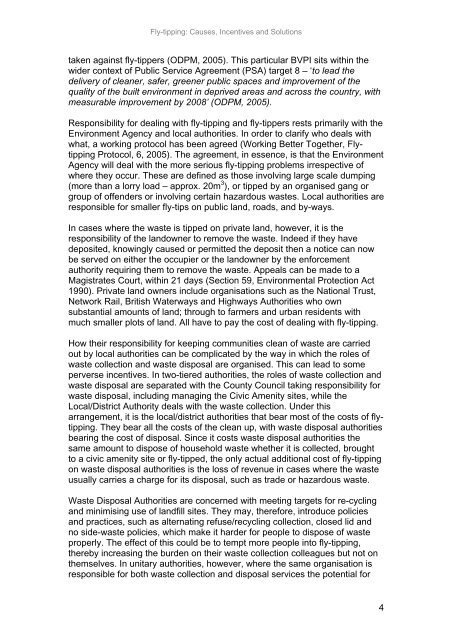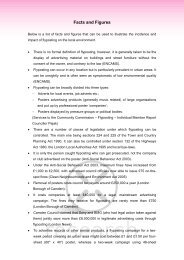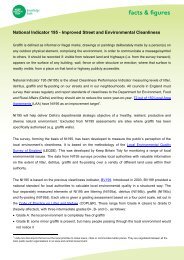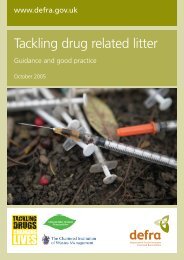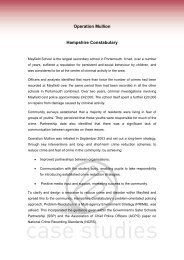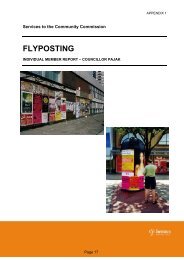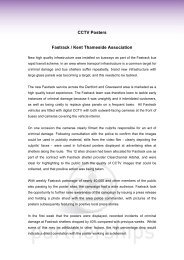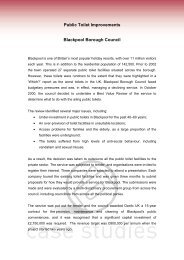Fly-tipping: Causes, Incentives and Solutions - Keep Britain Tidy
Fly-tipping: Causes, Incentives and Solutions - Keep Britain Tidy
Fly-tipping: Causes, Incentives and Solutions - Keep Britain Tidy
You also want an ePaper? Increase the reach of your titles
YUMPU automatically turns print PDFs into web optimized ePapers that Google loves.
<strong>Fly</strong>-<strong>tipping</strong>: <strong>Causes</strong>, <strong>Incentives</strong> <strong>and</strong> <strong>Solutions</strong><br />
taken against fly-tippers (ODPM, 2005). This particular BVPI sits within the<br />
wider context of Public Service Agreement (PSA) target 8 – ‘to lead the<br />
delivery of cleaner, safer, greener public spaces <strong>and</strong> improvement of the<br />
quality of the built environment in deprived areas <strong>and</strong> across the country, with<br />
measurable improvement by 2008’ (ODPM, 2005).<br />
Responsibility for dealing with fly-<strong>tipping</strong> <strong>and</strong> fly-tippers rests primarily with the<br />
Environment Agency <strong>and</strong> local authorities. In order to clarify who deals with<br />
what, a working protocol has been agreed (Working Better Together, <strong>Fly</strong><strong>tipping</strong><br />
Protocol, 6, 2005). The agreement, in essence, is that the Environment<br />
Agency will deal with the more serious fly-<strong>tipping</strong> problems irrespective of<br />
where they occur. These are defined as those involving large scale dumping<br />
(more than a lorry load – approx. 20m 3 ), or tipped by an organised gang or<br />
group of offenders or involving certain hazardous wastes. Local authorities are<br />
responsible for smaller fly-tips on public l<strong>and</strong>, roads, <strong>and</strong> by-ways.<br />
In cases where the waste is tipped on private l<strong>and</strong>, however, it is the<br />
responsibility of the l<strong>and</strong>owner to remove the waste. Indeed if they have<br />
deposited, knowingly caused or permitted the deposit then a notice can now<br />
be served on either the occupier or the l<strong>and</strong>owner by the enforcement<br />
authority requiring them to remove the waste. Appeals can be made to a<br />
Magistrates Court, within 21 days (Section 59, Environmental Protection Act<br />
1990). Private l<strong>and</strong> owners include organisations such as the National Trust,<br />
Network Rail, British Waterways <strong>and</strong> Highways Authorities who own<br />
substantial amounts of l<strong>and</strong>; through to farmers <strong>and</strong> urban residents with<br />
much smaller plots of l<strong>and</strong>. All have to pay the cost of dealing with fly-<strong>tipping</strong>.<br />
How their responsibility for keeping communities clean of waste are carried<br />
out by local authorities can be complicated by the way in which the roles of<br />
waste collection <strong>and</strong> waste disposal are organised. This can lead to some<br />
perverse incentives. In two-tiered authorities, the roles of waste collection <strong>and</strong><br />
waste disposal are separated with the County Council taking responsibility for<br />
waste disposal, including managing the Civic Amenity sites, while the<br />
Local/District Authority deals with the waste collection. Under this<br />
arrangement, it is the local/district authorities that bear most of the costs of fly<strong>tipping</strong>.<br />
They bear all the costs of the clean up, with waste disposal authorities<br />
bearing the cost of disposal. Since it costs waste disposal authorities the<br />
same amount to dispose of household waste whether it is collected, brought<br />
to a civic amenity site or fly-tipped, the only actual additional cost of fly-<strong>tipping</strong><br />
on waste disposal authorities is the loss of revenue in cases where the waste<br />
usually carries a charge for its disposal, such as trade or hazardous waste.<br />
Waste Disposal Authorities are concerned with meeting targets for re-cycling<br />
<strong>and</strong> minimising use of l<strong>and</strong>fill sites. They may, therefore, introduce policies<br />
<strong>and</strong> practices, such as alternating refuse/recycling collection, closed lid <strong>and</strong><br />
no side-waste policies, which make it harder for people to dispose of waste<br />
properly. The effect of this could be to tempt more people into fly-<strong>tipping</strong>,<br />
thereby increasing the burden on their waste collection colleagues but not on<br />
themselves. In unitary authorities, however, where the same organisation is<br />
responsible for both waste collection <strong>and</strong> disposal services the potential for<br />
4


